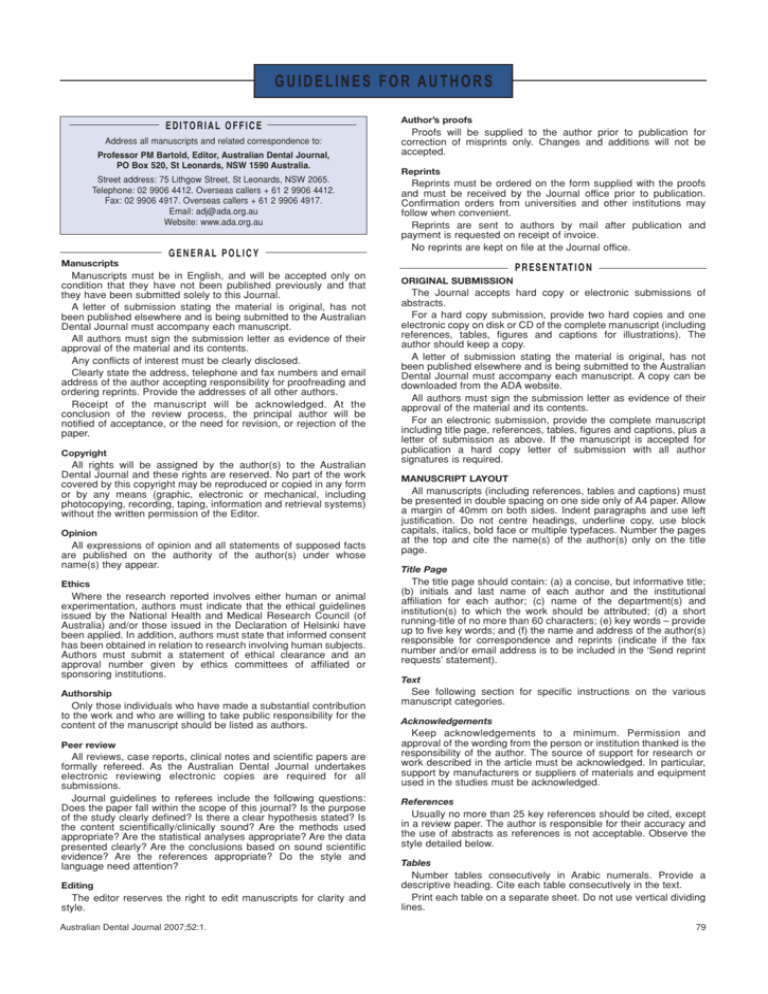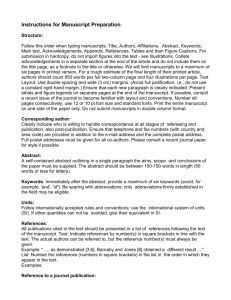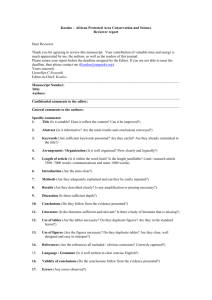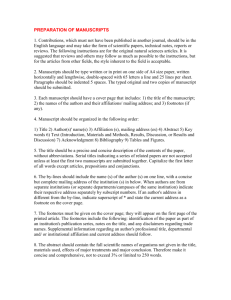
GUIDELINES FOR AUTHORS
EDITORIAL OFFICE
Address all manuscripts and related correspondence to:
Professor PM Bartold, Editor, Australian Dental Journal,
PO Box 520, St Leonards, NSW 1590 Australia.
Street address: 75 Lithgow Street, St Leonards, NSW 2065.
Telephone: 02 9906 4412. Overseas callers + 61 2 9906 4412.
Fax: 02 9906 4917. Overseas callers + 61 2 9906 4917.
Email: adj@ada.org.au
Website: www.ada.org.au
GENERAL POLICY
Author’s proofs
Proofs will be supplied to the author prior to publication for
correction of misprints only. Changes and additions will not be
accepted.
Reprints
Reprints must be ordered on the form supplied with the proofs
and must be received by the Journal office prior to publication.
Confirmation orders from universities and other institutions may
follow when convenient.
Reprints are sent to authors by mail after publication and
payment is requested on receipt of invoice.
No reprints are kept on file at the Journal office.
Manuscripts
Manuscripts must be in English, and will be accepted only on
condition that they have not been published previously and that
they have been submitted solely to this Journal.
A letter of submission stating the material is original, has not
been published elsewhere and is being submitted to the Australian
Dental Journal must accompany each manuscript.
All authors must sign the submission letter as evidence of their
approval of the material and its contents.
Any conflicts of interest must be clearly disclosed.
Clearly state the address, telephone and fax numbers and email
address of the author accepting responsibility for proofreading and
ordering reprints. Provide the addresses of all other authors.
Receipt of the manuscript will be acknowledged. At the
conclusion of the review process, the principal author will be
notified of acceptance, or the need for revision, or rejection of the
paper.
Copyright
All rights will be assigned by the author(s) to the Australian
Dental Journal and these rights are reserved. No part of the work
covered by this copyright may be reproduced or copied in any form
or by any means (graphic, electronic or mechanical, including
photocopying, recording, taping, information and retrieval systems)
without the written permission of the Editor.
Opinion
All expressions of opinion and all statements of supposed facts
are published on the authority of the author(s) under whose
name(s) they appear.
Ethics
Where the research reported involves either human or animal
experimentation, authors must indicate that the ethical guidelines
issued by the National Health and Medical Research Council (of
Australia) and/or those issued in the Declaration of Helsinki have
been applied. In addition, authors must state that informed consent
has been obtained in relation to research involving human subjects.
Authors must submit a statement of ethical clearance and an
approval number given by ethics committees of affiliated or
sponsoring institutions.
Authorship
Only those individuals who have made a substantial contribution
to the work and who are willing to take public responsibility for the
content of the manuscript should be listed as authors.
Peer review
All reviews, case reports, clinical notes and scientific papers are
formally refereed. As the Australian Dental Journal undertakes
electronic reviewing electronic copies are required for all
submissions.
Journal guidelines to referees include the following questions:
Does the paper fall within the scope of this journal? Is the purpose
of the study clearly defined? Is there a clear hypothesis stated? Is
the content scientifically/clinically sound? Are the methods used
appropriate? Are the statistical analyses appropriate? Are the data
presented clearly? Are the conclusions based on sound scientific
evidence? Are the references appropriate? Do the style and
language need attention?
Editing
The editor reserves the right to edit manuscripts for clarity and
style.
Australian Dental Journal 2007;52:1.
P R E S E N TAT I O N
ORIGINAL SUBMISSION
The Journal accepts hard copy or electronic submissions of
abstracts.
For a hard copy submission, provide two hard copies and one
electronic copy on disk or CD of the complete manuscript (including
references, tables, figures and captions for illustrations). The
author should keep a copy.
A letter of submission stating the material is original, has not
been published elsewhere and is being submitted to the Australian
Dental Journal must accompany each manuscript. A copy can be
downloaded from the ADA website.
All authors must sign the submission letter as evidence of their
approval of the material and its contents.
For an electronic submission, provide the complete manuscript
including title page, references, tables, figures and captions, plus a
letter of submission as above. If the manuscript is accepted for
publication a hard copy letter of submission with all author
signatures is required.
MANUSCRIPT LAYOUT
All manuscripts (including references, tables and captions) must
be presented in double spacing on one side only of A4 paper. Allow
a margin of 40mm on both sides. Indent paragraphs and use left
justification. Do not centre headings, underline copy, use block
capitals, italics, bold face or multiple typefaces. Number the pages
at the top and cite the name(s) of the author(s) only on the title
page.
Title Page
The title page should contain: (a) a concise, but informative title;
(b) initials and last name of each author and the institutional
affiliation for each author; (c) name of the department(s) and
institution(s) to which the work should be attributed; (d) a short
running-title of no more than 60 characters; (e) key words – provide
up to five key words; and (f) the name and address of the author(s)
responsible for correspondence and reprints (indicate if the fax
number and/or email address is to be included in the ‘Send reprint
requests’ statement).
Text
See following section for specific instructions on the various
manuscript categories.
Acknowledgements
Keep acknowledgements to a minimum. Permission and
approval of the wording from the person or institution thanked is the
responsibility of the author. The source of support for research or
work described in the article must be acknowledged. In particular,
support by manufacturers or suppliers of materials and equipment
used in the studies must be acknowledged.
References
Usually no more than 25 key references should be cited, except
in a review paper. The author is responsible for their accuracy and
the use of abstracts as references is not acceptable. Observe the
style detailed below.
Tables
Number tables consecutively in Arabic numerals. Provide a
descriptive heading. Cite each table consecutively in the text.
Print each table on a separate sheet. Do not use vertical dividing
lines.
79
Figures
Cite the figures consecutively throughout the text.
Provide the legends in list form on a separate sheet. Legends
should be understandable without reference to the text.
Provide two copies of each illustration identified by a label on the
back bearing the author’s name and the number of the figure.
Indicate the top. Do not write directly on the back of the illustration.
Illustrations may not be accepted if mounted in any way. Do not
bend them or fasten with paper clips or staples. Enclose them in an
envelope and protective wrapping.
Authors who wish to feature numerous illustrations should
contact the editor before final preparation of the paper.
Line drawings/graphs
Drawings, charts and graphs should be computer generated and
laser printed, at a size of 160mmx250mm. If symbols and
abbreviations are used, include a key. Do not use colour, except by
prior arrangement with the Editor. Lines should be 6 point, solid
black and text should be lower case, Times New Roman, bold, 14
point. For graph axes, place the axis legends parallel to the
relevant axis, with (if required) units in parentheses after the
legend. Differentiate between lines on graphs using different line
symbols, not different line styles. For bar charts, use open fill, solid
black fill, or a heavy patterned fill; do not use pale shading, small
dots or thin hatching. Do not use a shaded background to line
graphs or bar charts.
Photographs/radiographs
Provide clear, glossy, black-and-white untrimmed photographs.
The preferred size is 100x125mm or in that proportion. Written
permission must be obtained by the author for the publication of
recognizable photographs of patients or the convention of
obliterating the eyes will be used.
Provide original radiographs, where possible, rather than prints.
Use a transparent overlay for key lettering and to indicate the
vital area of radiographs and histological subjects as a guide
for reproduction, as well as for photomicrographs that require
the unit of length to be clearly stated in the form of a bar.
Example:
10µm
Digital Images
When supplying images electronically high resolution is required
(300 dpi). Supply images in tiff, eps or jpg (100% size) format. The
preferred size is 100x125mm or in that proportion. Please ensure
that images are not embedded in Word but are provided as
individual files.
REVISED MANUSCRIPT
When submitting revised manuscripts please include a detailed
cover letter indicating where changes have been made and
particular responses to the editorial and reviewers’ comments must
be provided and signed by all authors.
Authors should submit their revised manuscripts, including
tables, figures and illustrations, on disk or CD in PC or Mac format
or by email to adj@ada.org.au. The software programme and
version (for example, Microsoft Word version 6.0) must be
indicated on the diskette or CD label. Images must be supplied in
the formats specified above.
JOURNAL STYLE
Do not write in the first person.
Spelling
The spelling references are The Shorter Oxford English
Dictionary and Butterworths Medical Dictionary.
Mathematical expressions
Use the International System of Units of Measurement (SI units).
In some cases, it is acceptable to include non-SI units in
parentheses following the SI values.
Insert the leading zero in all numbers less than 1.0 in the text, in
tables, and in figures. Example: 0.5.
Do not leave a space between numbers and their accompanying
units. Examples: 10mg; 20˚C.
Use the words ‘per cent’ in the text according to context; but use
the symbol in formulas, equations, tables and illustrations.
Numbers in the text
Numbers may be spelt out or written as numbers, according to
context. As a general rule, if the number is less than 10, spell it out.
If the number is 10 or greater, it should be expressed as a number.
80
If a sentence begins with a number, spell it out. Example: Twentyseven patients took part in the study.
When citing inanimate quantities, use the number. Example: The
large increase in incidence may be partly explained by the use of
4ml of solution as standard.
Reference to illustrations
When referring to a figure at the beginning of a sentence, spell
the word out. Example: Figure 1 illustrates the cellular structure.
When referring to a figure within the sentence, abbreviate.
Example: The cellular structure is shown in Fig 2 and its complexity
should be noted.
When referring to a figure at the end of a sentence, abbreviate
and enclose in parentheses. Example: The complexity of the
cellular structure should be noted (Fig 3).
Proprietary names
Proprietary names must be cited in footnotes, or alternatively in
an appropriate table. State the manufacturer and the place of
manufacture. Example: Lederle Pharmaceuticals, Wolfratshausen,
Germany.
References
Cite references consecutively throughout the text by
superscripted numbers and, where applicable, they should appear
after punctuation. Example: This is in agreement with the work of
Smith,1 but not that of Jones.2
Provide the corresponding reference list on separate sheets at
the end of the paper following the Acknowledgements, if any.
References must conform to the Vancouver style except that page
numbers are not abbreviated (see below).
Cite the surname and initial(s) of authors without stops. In the
reference list when there are more than six authors to a paper, cite
the first three, then indicate et al. In the body of the text when there
are two authors cite both, when there are three or more then
indicate et al.
Cite the full title of the article without quotation marks and use
capitals only for the initial word and proper nouns.
Abbreviate the title of the Journal according to the Index to
Dental Literature or Index Medicus. State the year of publication,
the number of the volume (not the number of the issue) and the first
and last page numbers of the article.
In general, abstracts are not acceptable as references.
Examples of style
Observe the following, including the spacing and punctuation.
Journal: One or more authors
1. Ellis B, Lamb DJ. The setting characteristics of alginate
impression materials. Br Dent J 1981;151:343-346.
Journal: Corporate author
2. Therapeutics, Instruments, Materials and Equipment
Committee, Australian Dental Association. Cotton pellets and
gingival retraction cords. Clinical Notes No 2. Aust Dent J
1984;29:279.
Book: Single author
3. Nikiforu G. Understanding dental caries. 1. Etiology and
mechanisms: basic and clinical aspects. Basle: Karger,
1975:150-151.
Book: Two authors/later edition
4. Brand RW, Isselhard DE. Anatomy of orofacial structures. 2nd
edn. St Louis: Mosby, 1982:69-72.
Book: Editors as authors
5. Meyer J, Squier CA, Gerson SJ, eds. The structure and
function of oral mucosa. Oxford: Pergamon, 1984.
Book: Reference to a chapter
6. Carlsson GE, Haraldson T. Functional response. In: Brånemark
P-I, Zarb GA, Albrektsson T, eds. Tissue integrated prostheses.
Osseointegration in clinical dentistry. Chicago: Quintessence,
1985:155-163.
Thesis, monograph, dissertation
7. Kingsford-Smith ED. Marginal seal of cervical restorations.
Sydney: The University of Sydney, 1988. MDS thesis.
8. Cairns RB. Infrared spectroscopic studies of solid oxygen.
Berkeley, California: University of California, 1965. Dissertation.
Papers awaiting publication
These may appear as references, provided they have been
accepted by the Journal to which they have been submitted. They
should be cited as follows:
9. Grant TC. Chronic periodontitis. Int Dent J (in press).
Websites
When referring to a website, include the date it was accessed. If
the website only is cited, it should appear as a footnote. If the webAustralian Dental Journal 2007;52:1.
site is additional to a reference, it should be included at the end of
the reference as follows:
10. Australian Institute of Health and Welfare. Cancer in Australia.
Canberra: AIHW, 1998. URL: ‘http://www.aihw.gov.au’.
Accessed June 2005.
Written communications
These may be inserted in the text in parentheses or may appear
as footnotes, providing they bear the writer’s name and the date of
the communication. Example: (Smith GJ, written communication,
July 1986).
Unpublished observation, verbal communications
These may not be listed as references.
Introduction
M A N U S C R I P T C AT E G O R I E S A N D P R E PA R AT I O N
References
Submissions to the Australian Dental Journal should be limited to
one of the categories defined below. Specific information regarding
length and format is provided for each category. Please also refer to
the instructions provided under Presentation.
SCIENTIFIC ARTICLES
Scientific articles are papers that report significant clinical or basic
research in dentistry.
Abstract
The Journal uses a ‘structured abstract’ format. Accordingly, all
scientific articles should be submitted with an abstract, consisting of
no more than 200 words divided into four paragraphs under the
following headings:
• Background: Describing the problem being addressed.
• Methods: Describing how the study was performed.
• Results: Describing the primary results.
• Conclusions: Reporting what the authors have concluded from
their results, and their clinical implications, if relevant.
Introduction
The introduction should contain a concise review of the subject
area, the rationale for the study and where appropriate a clear
statement of any hypothesis to be tested. More detailed
comparisons with previous work and conclusions of the study
should appear in the Discussion section. The introduction should be
no longer than one and a half typed pages.
Materials and Methods
Materials and methods used in the study should be detailed so
that other investigators would be able to reproduce the research.
When established methods are used, the author need only refer to
previously published reports; however, the author should provide
brief descriptions of methods that are not well known or that have
been modified.
Results
The results should be presented in a logical sequence with
reference to tables, figures and illustrations as appropriate.
Discussion
New and possibly important findings of the study should be
emphasized. The data from the study should be compared with
previously published findings. Limitations of the experimental
methods should be discussed, as should implications for future
research. The clinical relevance of the findings of the study should
be included when appropriate. For the conclusions, it is not
acceptable to list a series of statements in either numerical or dotpoint format. Generally, the discussion should be no longer than
four typed pages.
References
In the introduction, a question or series of related questions to be
addressed are given; rationales for asking these questions and why
the question is timely should be explained.
Body
In the body, a sequence of logical subsections that reflect the
area being reviewed should be developed. This section should be a
critical analysis of the literature, including arguments needed to
support the conclusions reached and what issues remain
unresolved and need further study. Where appropriate, figures and
tables should be used to illustrate and summarize the information.
Colour illustrations are encouraged.
Relevant references should be kept to a minimum. Abstracts are
not considered to be an acceptable reference source.
CASE REPORTS AND CLINICAL NOTES
Case reports and clinical notes manuscripts will emphasize all
aspects of clinical dentistry. They should describe: (a) unique cases
that may represent a previously undescribed condition; (b)
unexpected association of two or more diseases; (c) adverse or
unexpected treatment response; (d) any other clinical observation
based upon well-documented cases that provides important new
information; or (e) a new or revised clinical technique or procedure.
Case reports and clinical notes need not be structured with the
same formality as scientific papers. They should be concise and
occupy no more than three Journal pages. Case reports and clinical
notes should be presented in the same format as specified in
Manuscript Layout.
Abstract
Case reports and clinical notes should be submitted with a
structured abstract consisting of no more than 250 words and the
following four paragraphs:
• Background: Describes the clinical situation being discussed.
• Methods: Describes the clinical procedures (surgical and nonsurgical) performed.
• Results: Describes the clinical results.
• Conclusions: Reports what the authors conclude, specifically
clinical implications in practice situations.
Introduction
The introduction should include a critical review of the pertinent
literature. There should be a clear statement of the implications of
the case for the primary or general dental practitioner.
Case Description and Results
The case description and results should describe the case(s) or
technique(s), including all relevant data. For case reports, present a
short history of the problem, what was done to help the patient,
report the outcome (whether it was a success or failure) and the
follow-up procedure. For clinical notes, present a short history of the
problem, how the technique or procedure was developed and how
it was evaluated. Carefully selected, high-quality clinical
photographs in full colour, as well as radiographs, are encouraged.
This portion of the report should be concise in presentation,
diagnostic investigations, treatment and follow-up.
Discussion
The discussion should be brief and to the point and, in particular,
should reinforce the message about the implications of the case for
the primary care provider as well as the specialists providing the
treatment. This should include findings, put into perspective with
respect to the field and literature. Unique arguments and new
information gained should be summarized. Consideration of the
clinical significance of the case(s) should be emphasized.
Relevant references should be cited. Usually no more than 25
references should be used. Abstracts are not considered to be an
acceptable reference source.
References
REVIEWS
LETTERS TO THE EDITOR
Generally, review articles will be solicited by the editor and are
intended to be focused reviews of basic and clinical science related
to all aspects of dentistry. Such reviews should address an
important and timely clinical question. The review should be based
on a critical assessment of the literature and may include data or
examples from the research or clinical experience of the author(s).
Authors should discuss clinical relevance and future projections.
Unsolicited submissions will be considered, but, to avoid duplicating
a topic already in preparation, authors should contact the editor
before developing a manuscript. Reviews should be no more than
10 Journal pages in length including figures, tables and references.
Letters may comment on articles published in the Journal and
should offer constructive criticism. When appropriate, comment on
the letter is sought from the author. Letters to the Editor may also
address any aspect of the profession, including education, new
modes of practice and concepts of disease and its management.
Letters should be brief (no more than two typed A4 pages in
minimum 12 point font with 2cm margins). Citations should be
handled as standard references. Due to production schedules it is
normally not possible to publish letters received in response to
material appearing in a particular issue earlier than the second or
third subsequent issues.
Abstract
The abstract should summarize the main conclusions of the
review in 350 words or less.
Australian Dental Journal 2007;52:1.
Relevant references to support the clinical findings must be
presented as for all other manuscript categories.
NOTE
If the Guidelines for Authors are not followed, manuscripts may be
returned unread to authors.
81









